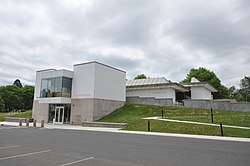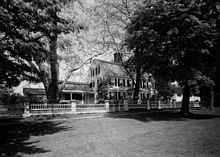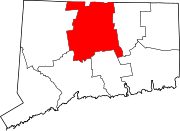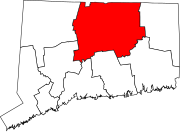Suffield, Connecticut
Suffield, Connecticut | |
|---|---|
 The Suffield Public Library | |
| Motto: "Our Roots Run Deep"[1] | |
| Coordinates: 41°59′N 72°41′W / 41.983°N 72.683°W | |
| Country | |
| U.S. state | |
| County | Hartford |
| Region | Capitol Region |
| Settled | 1670 |
| Incorporated (Massachusetts) | June 8, 1674 |
| Annexed by Connecticut | 1749 |
| Government | |
| • Type | Selectman-town meeting |
| • First selectman | Colin Moll (R) |
| • Selectmen | Template:PLainlist |
| Area | |
| • Total | 42.9 sq mi (111.2 km2) |
| • Land | 42.3 sq mi (109.5 km2) |
| • Water | 0.7 sq mi (1.8 km2) |
| Elevation | 197 ft (60 m) |
| Population (2020) | |
| • Total | 15,752 |
| • Density | 370/sq mi (140/km2) |
| Time zone | UTC−5 (Eastern) |
| • Summer (DST) | UTC−4 (Eastern) |
| ZIP Codes | 06078, 06093 |
| Area code(s) | 860/959 |
| FIPS code | 09-74540 |
| GNIS feature ID | 0212351 |
| Website | www |
Suffield is a town in Hartford County, Connecticut, United States. The town is part of the Capitol Planning Region, and located in the Connecticut River Valley. As of the 2020 census, the population was 15,752.[2] The town center is a census-designated place listed as Suffield Depot.
Bordering Massachusetts, Suffield is part of the Springfield, Massachusetts NECTA. It was once within the boundaries of Massachusetts.
History
[edit]Originally known as Southfield—pronounced "Suffield," on May 20, 1674, the committee for the settling of the town petitioned:
...that the name of the place may be Suffield, it being the southernmost town that either at present is, or like to be in that Countrey, and neere adjoining to the south border of our Patent in those parts. [sic]
The petition was granted by the Massachusetts Bay court on June 8, 1674. Suffield was incorporated as a town in March 1682.[3]
Also, on early 17th and 18th century maps, Suffield was alternatively spelled as Suthfield.
Suffield and the surrounding area were part of the Equivalent Lands compromise with Massachusetts in 1715–1716.[4]
Suffield's native and adopted sons include The Rev. Ebenezer Gay, a renowned Congregational minister; U.S. Postmaster General Gideon Granger; real estate speculator Oliver Phelps, once the largest landowner in America; composer Timothy Swan; architect Henry A. Sykes; sculptor Olin Levi Warner; Seth Pease, surveyor of the Western Reserve lands in Ohio, most of which were controlled by Suffield financiers and speculators; and Thaddeus Leavitt,[5] inventor of an early cotton gin, merchant and patentee of the Western Reserve lands.[6] Thanks to the town's early prominence and wealth, it boasts an astonishing collection of early New England architecture.[7] The Kent family, for whom the town's library is named, originated in Gloucester, Massachusetts, and boasted relations to many prominent early New England families, including the Dwight family of Northampton, Massachusetts, the Hooker family of Hartford, the Dudleys of Guilford, Connecticut, and the Leavitts of Suffield.[8][9] Descendants of Robert Olds, who arrived from Sherborne, Dorset, in 1667, include automotive pioneer Ransom Eli Olds, Copperhead Ohio politician Edson Baldwin Olds, his great-grandson USAAF General Robert Olds, and his son, iconic USAF fighter pilot Robin Olds.
Slavery was common throughout the Connecticut River Valley during the 18th century, and the 1774 Census for the Colony of Connecticut listed 37 slaves in Suffield. Throughout the Connecticut Valley, wealthy merchants, tavern owners and town ministers owned slaves. When Major John Pynchon originally purchased from the Pequonnocks and Agawam tribes a six-mile tract of land, which he called Stoney Brooke Plantation, he first ordered the construction of a sawmill, and used two of his slaves, Harry and Roco, for the construction.[10] Suffield's third minister, Reverend Ebenezer Devotion, became minister in 1710, and "sixteen years later the town voted to give him £20 to purchase a slave.[11] Reverend Ebenezer Gay, Devotion's successor, owned six slaves throughout his long term, 1742–1796. Reverend Ebenezer Gay Jr. manumitted his family's three remaining slaves in 1812. They were Titus, Ginny and Dinah.[12] "Princess," a slave belonging to early Suffield settler, Lieut. Joshua Leavitt, died November 5, 1732.[13] Some of Leavitt's descendants became ardent abolitionists, including Joshua Leavitt and his cousin Roger Hooker Leavitt, who operated an Underground Railroad station in Charlemont, Massachusetts.
One of the earliest graduates of the Yale Medical School was one of Suffield's earliest physicians. Dr. Asaph Leavitt Bissell, born in 1791 at Hanover, New Hampshire, to parents originally from Suffield,[14] attended Dartmouth College, and later graduated in the second class of the Yale Medical School. Bissell moved to Suffield, where he rode horseback to make house calls on his patients. Bissell's saddlebags are today in the collection of the Yale Medical School's Historical Society.[15]
Geography
[edit]According to the United States Census Bureau, the town has a total area of 42.9 square miles (111.2 km2), of which 42.3 square miles (109.5 km2) is land and 0.69 square miles (1.8 km2), or 1.58%, is water.[16] The town center (Suffield Depot CDP) has a total area of 2.0 square miles (5.1 km2), all of it land.
Suffield is on the west bank of the Connecticut River, 8 miles (13 km) south of the river's largest city, Springfield, Massachusetts, and 16 miles (26 km) north of Connecticut's capital, Hartford. Two bridges span the river to the town of Enfield: the Amtrak/Springfield Terminal Railroad Bridge and the Enfield–Suffield Veterans Bridge.
The Metacomet Ridge, a mountainous trap rock ridgeline that stretches from Long Island Sound to nearly the Vermont border, runs through the center of Suffield from south to north as West Suffield Mountain. The 51-mile (82 km) Metacomet Trail traverses the ridge.
Demographics
[edit]| Census | Pop. | Note | %± |
|---|---|---|---|
| 1850 | 2,962 | — | |
| 1860 | 3,260 | 10.1% | |
| 1870 | 3,277 | 0.5% | |
| 1880 | 3,225 | −1.6% | |
| 1890 | 3,169 | −1.7% | |
| 1900 | 3,521 | 11.1% | |
| 1910 | 3,841 | 9.1% | |
| 1920 | 4,070 | 6.0% | |
| 1930 | 4,346 | 6.8% | |
| 1940 | 4,475 | 3.0% | |
| 1950 | 4,895 | 9.4% | |
| 1960 | 6,779 | 38.5% | |
| 1970 | 8,634 | 27.4% | |
| 1980 | 9,294 | 7.6% | |
| 1990 | 11,427 | 23.0% | |
| 2000 | 13,552 | 18.6% | |
| 2010 | 15,735 | 16.1% | |
| 2020 | 15,752 | 0.1% | |
| U.S. Decennial Census[17] | |||
As of the census[18] of 2000, there were 13,552 people, 4,660 households, and 3,350 families residing in the town. The population density was 321.0 inhabitants per square mile (123.9/km2). There were 4,853 housing units at an average density of 115.0 per square mile (44.4/km2). The racial makeup of the town was 88.67% White, 6.95% African American, 0.24% Native American, 0.94% Asian, 0.04% Pacific Islander, 2.03% from other races, and 1.13% from two or more races. Hispanic or Latino of any race were 4.25% of the population.
There were 4,660 households, out of which 32.8% had children under the age of 18 living with them, 62.2% were married couples living together, 6.9% had a female householder with no husband present, and 28.1% were non-families. Of all households, 23.3% were made up of individuals, and 11.6% had someone living alone who was 65 years of age or older. The average household size was 2.55 and the average family size was 3.04.
In the town, the population was spread out, with 22.1% under the age of 18, 8.0% from 18 to 24, 31.7% from 25 to 44, 24.1% from 45 to 64, and 14.1% who were 65 years of age or older. The median age was 39 years. For every 100 females, there were 116.9 males. For every 100 females age 18 and over, there were 121.1 males.
The median income for a household in the town was $66,698, and the median income for a family was $79,189. Males had a median income of $52,096 versus $35,188 for females. The per capita income for the town was $28,171. About 1.8% of families and 3.6% of the population were below the poverty line, including 2.5% of those under age 18 and 6.2% of those age 65 or over.
Arts and culture
[edit]Historic homes and sites
[edit]

Main Street, a designated historic district with the Green, three churches, Suffield Academy and vintage colonial and Victorian homes, typifies a New England town. Named for the Kent family of Suffield, the Kent Memorial Library is an important research center for source materials, records, and documents from north-central Connecticut. A walk along Main Street reveals many examples of 18th and 19th century architecture. The Dr. Alexander King House, on the corner of Kent Avenue, and the Phelps-Hatheway House, a little farther north on Main Street, are museums open to the public from May to October.
Historic sites
[edit]Sites listed on the National Register of Historic Places include:[19]
- Alexander King House
- Babb's Beach
- Farmington Canal-New Haven and Northampton Canal – roughly from Suffield to New Haven
- Gothic Cottage
- Hastings Hill Historic District
- Hatheway House (also known as "Phelps-Hatheway House and Garden") – reflects two architectural styles: the original 1761 building is a typical colonial house, the 1794 north wing is one of the first examples of the Neoclassical style in the Connecticut River Valley[20]
- Hilltop Farm[21]
- John Fuller House
- King's Field House
- Lewis-Zukowski House
- Suffield Historic District
Government
[edit]Voter registration
[edit]| Voter Registration and Party Enrollment as of November 1, 2022[22] | |||||
|---|---|---|---|---|---|
| Party | Active Voters | Inactive Voters | Total Voters | Percentage | |
| Democratic | 2,566 | 205 | 2,771 | 25.86% | |
| Republican | 2,763 | 215 | 2,978 | 27.80% | |
| Unaffiliated | 4,197 | 447 | 4,644 | 43.35% | |
| Minor parties | 294 | 27 | 321 | 2.99% | |
| Total | 9,820 | 894 | 10,714 | 100% | |
List of First Selectmen
[edit]| Representative | Party | Years | Note |
|---|---|---|---|
| Roland Dowd | Suffield Community Party | 1995–1997 | Defeated for reelection |
| Robert Skinner | Republican | 1997–2001 | Did not seek reelection |
| Elaine Sarsynski | Republican | 2001–2005 | Did not seek reelection |
| Scott Lingenfelter | Republican | 2005–2009 | Defeated for reelection |
| Tom Frenaye | Democratic | 2009–2011 | Defeated for reelection |
| Edward McAnaney | Republican | 2011–2015 | Defeated for reelection |
| Melissa Mack | Democratic | 2015–2021 | Defeated incumbent by a 637-vote margin, ran unopposed in two subsequent elections, defeated for reelection after third term |
| Colin Moll | Republican | 2021–present |
Education
[edit]The town's public school system, Suffield Public Schools, includes Spaulding Elementary School, McAlister Intermediate School, Suffield Middle School, and Suffield High School.
Suffield is also the home of Suffield Academy, a private coeducational preparatory school.
Notable people
[edit]- Willis Seaver Adams (1842–1921), landscape painter and part of the Tonalism movement which took place in the late 19th century; born in Suffield[23]
- Ran Blake, pianist
- Selden M. Bronson, former Wisconsin State Assemblyman
- Sylvester Graham (1794–1851), American dietary reformer; born in Suffield[24]
- Amos P. Granger, former US Congressman
- Francis Granger, former US Congressman and Postmaster General
- Gideon Granger, former US Postmaster General
- Judson Worthington Hastings (1853–1923), physician and public official
- George M. Hendee. Founder of Indian Motorcycle; moved to Suffield after retiring
- Chris Kellogg, current morning host of The Kellogg Krew morning show on WMAS-FM
- Titus Kent (fl. 1775–1783), an enslaved man who enlisted as a Connecticut militiaman for eight years in the American Revolutionary War.
- W. Bruce Lincoln, scholar of Russian history
- Thaddeus J. Martin. Major General in the United States Air Force and Connecticut Adjutant General
- Eliphalet Remington, Engineer and founder of Remington Arms, born in Suffield
- David Newton Sheldon, 5th President of Colby College
- Israel Smith (1759–1810), served as a member of the United States House of Representatives, a member of the United States Senate and Governor of Vermont; born in Suffield[25]
- Noah Smith (1756–1812), brother of Israel Smith, Justice of the Vermont Supreme Court[26]
- Timothy Swan (1758–1842), composer and hatmaker; resident of Suffield[27]
- Emily Sweeney, member of 2018 US Olympic luge team
- John Tod (1779–1830), United States Congressman for Pennsylvania
See also
[edit]References
[edit]- ^ "Town of Suffield Connecticut". Town of Suffield Connecticut. Retrieved September 22, 2012.
- ^ "Census - Geography Profile: Suffield town, Hartford County, Connecticut". United States Census Bureau. Retrieved December 21, 2021.
- ^ Sellers, Helen Earle (no date, c. 1965; reprint from The Connecticut Register and Manual, 1942 Edition). Connecticut Town Origins: Their Names, Boundaries, Early Histories and First Families. Stonington, Connecticut: The Pequot Press. p. 81.
- ^ Crockett, Walter Hill (March 18, 1921). "Vermont, the Green mountain state". New York, The Century history company, inc. – via Internet Archive.
- ^ Leavitt's daughter Jane Maria Leavitt, wife of Vermont Congressman Jonathan Hunt was the mother of architect Richard Morris Hunt, painter William Morris Hunt and photographer Leavitt Hunt
- ^ "Historic Suffield". www.suffield-library.org.
- ^ "Suffield Historical Society". www.suffieldhistoricalsociety.org.
- ^ "Family History of Samuel Kent, Suffield Historical Society". Archived from the original on January 23, 2009. Retrieved April 10, 2008.
- ^ "Genealogical Notes, or Contributions to the Family history of Some of the ..." March 18, 1856 – via Internet Archive.
- ^ Slavery in the Connecticut Valley of Massachusetts 2009, Robert H. Romer
- ^ Slavery in the Connecticut Valley of Massachusetts 2009, Robert H. Romer
- ^ "Colonial Slavery". www.suffield-library.org. Retrieved January 22, 2013.
- ^ "Documentary History of Suffield: In the Colony and Province of the Massachusetts Bay, in New England, 1660-1749". C.W. Bryan Company. March 18, 1879 – via Google Books.
- ^ Benjamin Woodbridge Dwight (1874). The history of the descendants of John Dwight, of Dedham, Mass. Vol. 1. J. F. Trow & son, printers and bookbinders. ISBN 9780788448911.
- ^ When house calls were horse calls, Yale Medicine, Winter/Spring 1998
- ^ "Geographic Identifiers: 2010 Demographic Profile Data (G001): Suffield town, Hartford County, Connecticut". U.S. Census Bureau, American Factfinder. Archived from the original on February 12, 2020. Retrieved November 28, 2012.
- ^ "Census of Population and Housing". Census.gov. Retrieved June 4, 2015.
- ^ "U.S. Census website". United States Census Bureau. Retrieved January 31, 2008.
- ^ "National Register Information System". National Register of Historic Places. National Park Service. March 13, 2009.
- ^ Connecticut, Massachusetts & Rhode Island Tourbook, 2007 edition (2007). p. 60. AAA Publishing, Heathrow, Florida
- ^ "George Hendee farm | Hilltop Farm Suffield | Suffield, CT". Hilltop Farm.
- ^ "Registration and Party Enrollment Statistics as of November 1, 2022" (PDF). Connecticut Secretary of State. Archived from the original (PDF) on October 22, 2023. Retrieved October 21, 2023.
- ^ "Willis Seaver Adams (1844-1921)". Kent Memorial Library. Retrieved October 22, 2012.
- ^ "Sylvester Graham (1794-1851)". Suffield Library. Retrieved October 22, 2012.
- ^ "Vermont Governor Israel Smith". National Governors Association. Retrieved October 22, 2012.
- ^ Taft, Russell S. (January 1, 1894). "The Supreme Court of Vermont, Part II". The Green Bag. Boston: Boston Book Company.
- ^ "Timothy Swan (1758-1843)". Suffield Library. Retrieved October 22, 2012.








